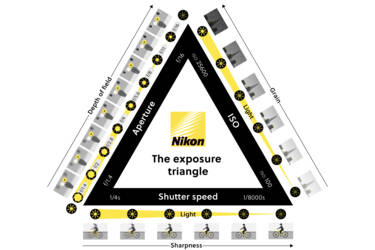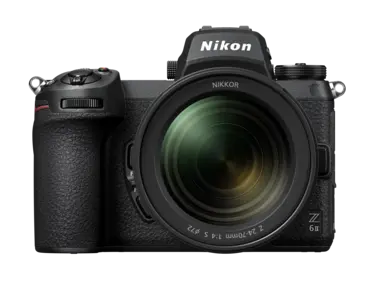Mastering the exposure triangle: everything you need to know

To start your photography journey you need to know aperture, ISO and shutter speed. Here’s why
Getting the hang of exposure can be intimidating for new photographers. Balancing the many variables and learning how they interact takes time. But manipulating exposure becomes instinctive once you get over the initial learning curve. Here, we’ll explore how to master the exposure triangle.
What is the exposure triangle?
Three elements properly expose your photo, each making up a ‘side’ of the exposure triangle. They are:
- Aperture
- Shutter speed
- ISO
Each element affects the brightness of your image in different ways, using different mechanisms. You can also control more creative aspects of your image depending on which setting you change. We’ve outlined more in-depth tutorials for each one, but we’ll review them briefly here.

From left to right: f/2.8, f/6.3, f/13, f/22. Z6II + NIKKOR Z 24-70mm f/2.8 S at 70mm focal length
Understanding aperture
The aperture is the opening inside your camera’s lens that lets light through to the sensor. It can vary in size to let more or less light in, thereby brightening or darkening your image.
Controlling aperture also lets you determine what’s in focus in your image. Very wide apertures let a lot of light in, but only a sliver of what you see will be in focus. Smaller ones provide a sharper image, but don’t let as much light through. Neither is better or worse than the other. It’s about knowing which to use for the situation.
Aperture setting measurements are called f-stops, f-numbers or simply aperture. An example would be f/1.2. The lower the number is, the wider the opening, so f/1.2 is quite wide. Higher numbers such as f/16 or f/22 denote smaller apertures.

Play around with shutter speed until you achieve the desired result. From left to right, top to bottom: 1/15, 1/40, 1/125, 1/400, 1/1000, 1/4000 shutter speed.
Understanding shutter speed
Your shutter is the part inside your camera that opens and closes to let light through to the sensor, like shutters on a window. Light hits it after coming through the aperture in your lens.
Opening the shutter lets light through to the camera’s sensor. Shutter speed is how fast it will open and close and is measured in fractions of a second to full seconds. Slower shutter speeds (such as 1/15 secs) cause blur in your image, while faster ones freeze motion. 1/1000th of a second, for example, is a high shutter speed commonly used to freeze fast-moving subjects such as wildlife. Faster shutter speeds darken your photo because they only let light through for a small fraction of a second, giving it less time to register on your camera’s sensor.

The same shot with different ISO settings. From 100 ISO at 1/2000 sec and f/11 to 20,000 ISO at 1/2000 sec and f/11.
Understanding ISO
ISO refers to how your sensor reads light, specifically its sensitivity to light. Physical film has a set ISO number, but digital cameras can change it on the fly.
Lower ISO numbers, such as 100, denote a low sensitivity to light. Higher ones, for example, 1,600, boost light sensitivity. Higher ISO settings will produce digital grain in your photos called ‘noise’, though modern cameras have improved noise reduction. For that reason, lower ISO settings are often recommended whenever possible.

The exposure triangle
Putting it all together
Changing one setting almost always means changing others to accommodate it. A faster shutter speed, for example, may require you to boost your ISO or open your aperture wider for a bright enough image. How your settings balance each other will depend on the photo you’re trying to make.
Say you’re photographing birds in the wild. You want a shot that freezes one in flight with no blur. You’ll need a fast shutter speed, but also a narrow enough aperture to get the whole bird in sharp focus. Both will darken your image, so how would you get a well-exposed photograph that meets your goal?
One way to figure this out is to work backwards from your most essential setting. In this situation, that’s shutter speed because you need to freeze motion. Say you need a speed of 1/2000th of a second. How can you get a brighter image with your other settings? You could:
- Open your aperture wider
- Boost your ISO
Look at your next most essential setting after shutter speed: an aperture that gets everything in focus. Since you want to be sure your image is sharp, you’ll want to avoid wider settings such as f/1.4 or f/1.8, because those only get a small slice of your image in focus. You’ll need to choose a setting that’s still relatively wide to let in more light while narrow enough to get the bird in focus, probably f/4 to f/5.6.
Lastly, look at your ISO. To avoid noise, you’ll want to keep it on the lower side, but don’t be afraid to raise it enough to get a bright photo. To dial your ISO in, take a few test shots after figuring out your shutter speed and aperture. Once you’ve settled on something that gives you a nice bright exposure, you’re ready to go.
As you use your camera, you’ll learn to do this balancing act for each situation you find yourself in. There are no exact perfect settings for every situation, only general guidelines. If it all seems overwhelming to try at once, don’t worry. Focus on one setting at a time using modes such as aperture priority or shutter priority and build out from there. As with the other tenets of photography, mastering the rules of the exposure triangle will help you to bend them later.
More in Camera 101s
Featured products
Better photography starts here

Unlock greater creativity












